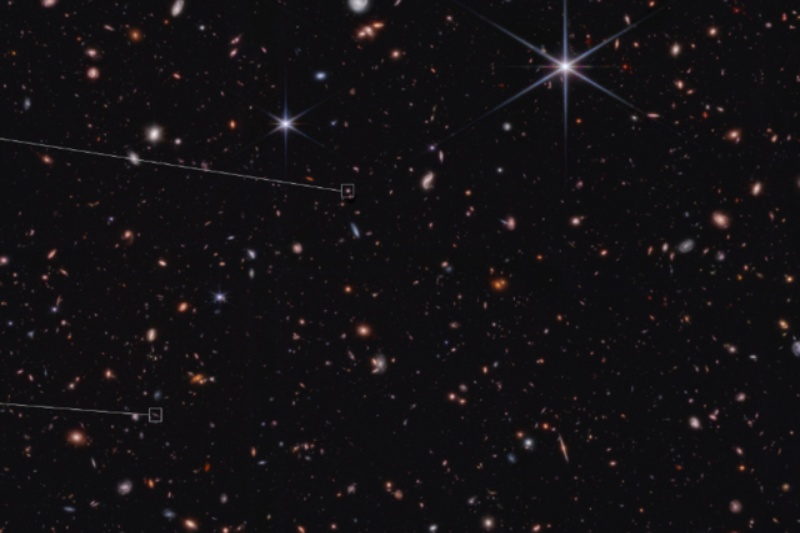Galaxies in the early universe are rarely circular, like volleyballs or frisbees, but more frequently flat and extended, like surfboards and pool noodles, according to research examining photos from NASA’s James Webb Space Telescope. Lead author Viraj Pandya, a NASA Hubble Fellow at Columbia University in New York, said that “roughly 50 to 80% of the galaxies we studied appear to be flattened in two dimensions.” “It’s surprising that galaxies that resemble pool noodles or surfboards appear to be very common in the early universe, considering they are uncommon nearby.”
The Cosmic Evolution Early Release Science (CEERS) Survey, a large field of near-infrared pictures provided by Webb, was the team’s primary focus. They identified galaxies that are thought to have existed between 600 million and 6 billion years ago.
Some distant galaxies have shapes similar to volleyballs and frisbees, but the majority resemble surfboards and pool noodles. The sphere-shaped galaxies, sometimes known as “volleyballs,” are the least common and appear to be the most compact variety on the cosmic “ocean.” It was discovered that the frisbees in the neighboring cosmos were as big as the galaxies fashioned like surfboards and pool noodles along the “horizon,” but they became more prevalent closer to the “shore.”
If we could travel back billions of years, which category would our Milky Way galaxy fit into? The University of Arizona in Tucson PhD candidate Haowen Zhang, a co-author, speculated that the object might have resembled a surfboard. Theorists have “wound back the clock” to estimate the Milky Way’s mass billions of years ago, which correlates with form at that time. This idea is based in part on fresh evidence from Webb.
These distant galaxies are also far less massive than nearby spirals and ellipticals – they are precursors to more massive galaxies like our own. “In the early universe, galaxies had had far less time to grow,” said Kartheik Iyer, a co-author and NASA Hubble Fellow also at Columbia University. “Identifying additional categories for early galaxies is exciting – there’s a lot more to analyze now. We can now study how galaxies’ shapes relate to how they look and better project how they formed in much more detail.”
Thanks to Webb’s sensitivity, high-resolution photos, and expertise in infrared light, the team was able to quickly characterize and predict the 3D geometries of several CEERS galaxies. Pandya adds that without the substantial study astronomers have conducted with NASA’s Hubble Space Telescope, their work would not be conceivable.
With its initial “deep field” in 1995 and its groundbreaking Cosmic Assembly Near-infrared Deep Extragalactic Legacy Survey, Hubble has been wowing us with photos of some of the earliest galaxies for decades. These kinds of deep sky surveys produced far larger numbers, which enabled astronomers to build reliable 3D models of far-off galaxies spanning the entirety of cosmic time. By contributing a wealth of far-off galaxies that are out of Hubble’s grasp and providing a significantly more detailed picture of the early cosmos than was previously conceivable, Webb is currently aiding in the enhancement of these endeavors.
Like a wave of water, Webb’s pictures of the early universe have revealed new pieces of information. Co-author Marc Huertas-Company, a faculty research scientist at the Institute of Astrophysics on the Canary Islands, stated, “Hubble has long shown an excess of elongated galaxies.” Researchers were still unsure, though, whether more sensitivity to infrared light would result in enhanced detail visibility. Hubble’s observations of the galaxies were verified by Webb to show that no extra features were overlooked. Furthermore, Webb’s detailed images of many more far-off galaxies with comparable shapes were shown to humankind.
Researchers will need to invest sufficient time in fine-tuning and updating their models to better reflect the specific geometries of distant galaxies, in addition to need an even larger sample size from Webb to further refine the features and precise locations of distant galaxies. Co-author Elizabeth McGrath, an associate professor at Colby College in Waterville, Maine, noted that these were preliminary findings. “These early trends excite us, but we need to dig deeper into the data to understand what’s going on.”
The best space scientific observatory in the world is the James Webb Space Telescope. Webb is delving into the enigmatic structures and beginnings of our universe and our place within it, as well as uncovering riddles inside our solar system and exploring far-off worlds orbiting other stars. The European Space Agency (ESA) and the Canadian Space Agency are partners in the multinational Webb program, which is headed by NASA.





